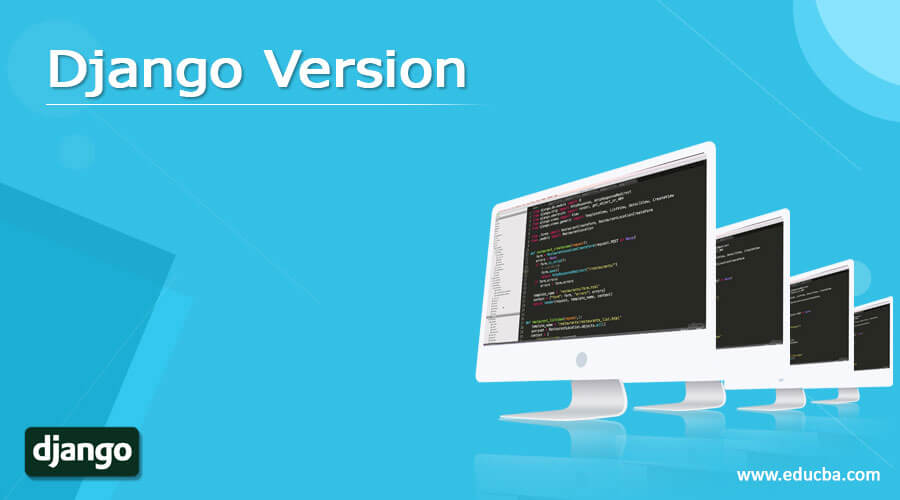
Introduction to Django Version
A free framework based on Python that has a pattern of a model to the template to view that helps in developing websites is called the Django framework. It acts as a toolkit for all levels of application development. Perfect websites can be created with the help of Python libraries, and the codes can be used for both the frontend and backend. Object-oriented concepts are really important in Django; hence, the base knowledge of Python is necessary to work in Django. Custom applications can be created easily without much code, making the websites perfect for users.
Top Django Versions
- Django was developed in 2003 as a web application to create websites with the help of Python. Adrian Holovaty, Simon Willison, and Jacob Kaplan-Moss were involved in the development, which was released to the market in 2005. The name Django was given after the guitarist Django Reinhardt. A web server is available for developing web applications and testing the same, along with a template system that works based on the OOPs concept. The template has inheritance built within itself. It can be used along with other applications as well. Also, a framework is available to collect geographic data that help predict the weather.
- The initial release of 0.90 was made public on 16 Nov 2005. The next version, 0.91 was released in January 2006 with few changes, such as adding new admins to the application. The next version, 0.95 was in July, which helped the users to remove templates or any other features added to the website faster than ever. Testing tools were provided inside the application in the next version 0.96, released in March 2007. In 2008, Django Software Foundation was formed to undertake all the version releases and questions related to Django.
- Version 1.0 was released in September 2008 with API support and multiple admin support. Also, Unicode can be used in this version. 1.1 was released after a year which helps in doing tests based on transactions and helps in the aggregation of codes for adding more features to the web application being developed by the user. 1.2 version was released in May 2010, which helps connect with different databases and helps in validating any web model. More security was provided to the website during this version with the help of CSRF or cross-site request forgery. March 2011 saw the release of the 1.3 version, which helps maintain static files and helps users view the web application based on classes.
- The first Long Term Support version 1.4 was released in March 2021 with different time zones that help users to set their application for users from other countries. This version also supported testing web applications within the browser itself and managing the application templates within the web application. Python 3 was developed by then, so the next version, 1.5 released after a year, saw Python 3 support in the framework. Also, a custom model can be created in this version configured in Python 2 and 3.
- 6 version of November 2013 helped users in database transactions and connections with different databases. This version and many others had Malcolm Tredinnick’s signature; thus, the 1.6 version is dedicated to him. 1.7 version, which was released in September 2014, helped in configuring other applications in Django and migrating Django to other platforms. The 1.8 version was released in April 2015 with long-term support that ended in 2018. Different template engines were supported in 1.8. The 1.9 version of December 2015 saw a new user interface and automated validation of passwords. August 2016 saw the release of the 1.10 version, which helped in new style middleware formation and automated search of PostgreSQL. By 2017 Python 3 version could be found everywhere; hence, the next version, 1.11 released in April 2017 was the last supported version of Python 2. Soon after, users saw the release of version 2.0 in December 2017 with Python 3 support which was welcomed by mobile users more. It had mobile-friendly syntax and an admin setup. The URL is simplified in version 2.0, which helps users know the web applications model differently. 2.1 was released in August 2018, with model and view permissions within the application.
- All the above versions discussed are no longer supported now as Django has seen many newer versions.
- 2 version was released in April 2019, which is Long Term Support till April 2022. It saw more security and friendly features in the release. There was no ASGI support for all the above versions, which we can see in version 3.0 released in December 2019. Also, the 3.1 release happened in August 2020 with middleware support and different views asynchronously. 2.2,3.0,3.1 versions, even though old is still maintained by the foundation with extended support.
- 2 version was released in Apr 2021, which be supported till April 2024. The changes can be seen in the user interface and minor changes in the coding pattern. All these version releases helped make Django a preferable application for users for web development. Other versions till 2023 are planned with the changes to be made.
- Codes are present in Django itself, and users can update the same code using any text editor and customize the same for their personal usage. It is better to use IDE as we can transfer the codes easily, and if it is based on Python, it will be more beneficial. Community support is huge for Django as developers directly saw a necessary change in Django as a web application.
Conclusion – Django Version
Though Django prefers using Python, it can be ported to other programming languages such as Ruby, Perl, JavaScript, and Erlang. Cross-platforms work for Python, but users must be careful while converting all the codes used in Django. Also, management of entire content, as well as database transactions, can be done by Django easily.

